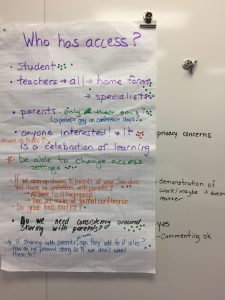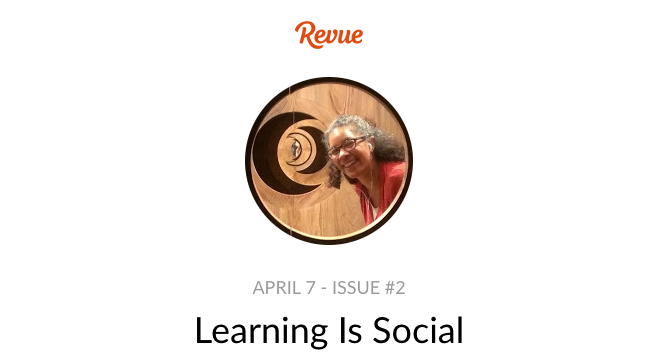Greasing the Wheels of Innovation
Cross-posted from Cohort21 – April 7, 2017
—
In my last post, I shared some of what I learned in the Launching Innovation in Schools EdX MOOC. In that first unit, there was a description about how school leaders can help to accelerate the cycle of experiment and experience for teachers:
-

Pete. The View From Below. 2011. Public Domain license via flickr.com Accessed April 7, 2017. Provide resources for research and development. Resources could be in the form of time, access to expertise, coaching, etc.
- Create conditions for team learning that get teachers to collaborate and learn from one another. This could be by utilizing protocols for looking at student work, participating in instructional rounds, etc.
- Ensure that there are opportunities for systemic institutional learning through teacher-led PD, more time for sharing innovative practices at meetings, etc.
- Develop a shared vision and common instructional language
Thus, in order to start to create a safe environment for teachers to share ideas and take risks, I wanted to share resources and begin to put processes in place.
Sharing Resources
IDEA #1: A Newsletter
Since I read a lot of blogs and come across a lot of ideas for how to integrate technology in the classroom, I often want to share these ideas with colleagues. Sometimes I email them but I don’t want to be a nuisance to people so I thought that maybe a newsletter could help.
I remembered how at ISTE 2016 I attended a session entitled: Flip Your PD: Digital Tools to Support Anytime, Anywhere Learning. Holly Gillam and Melissa Pickens shared how they use MailChimp to share ideas before faculty meetings or as follow-up to PD sessions. It made information look more interesting than in an email so I gave that a go but managing what I wanted to share lead to having too many lists to manage.
More recently I was listening to a podcast (unfortunately, I no longer know which one) that introduced me to Scott Monty’s newsletter. He regularly writes about current events and trends related to a specific list of topics. I really liked this idea providing up-to-date information about a stable list of topics and wondered if/ how I could use it at school.
I learned about the Revue newsletter creator that allows you to save links as you come across them and later assign them to specific newsletters using their Chrome Extension or iOS app. This seemed perfect! Just before March Break I used this tool to publish the first issue of my newsletter to share ideas that teachers might want to consider and linked them back to what we have stated in our ICT philosophy. I received positive reviews and published my second issue just this week.
IDEA #2: A Website
I not only want to share new possibilities with teachers but I also want to document and celebrate what is already happening in classes to support our policy and philosophy documents. At the last Face-to-Face session for Cohort21, Lisa Bettencourt shared how she was planning to create a website to visually share ideas. Ever since we developed our Technology Standards, my Integrator colleague and I have thought that we should provide links to what they could look like at different grades. A Pinterest-like website sounds like a great way to do this and is on my ToDo list!
Design Thinking Process
As referenced in previous posts, I really like the Design Thinking process – it keeps work focused in the end-user and encourages creativity. I have attempted to utilize a design thinking process with two groups I am working with.
PROCESS #1: ePortfolios
I am currently working with Primary Faculty on utilizing ePortfolios in the classroom. This has been a purposefully slow process that was begun back in June 2016. Here’s how we have utilized Design Thinking so far:
- Empathize/ Learn from people – last June we shared our ideas and concerns regarding digital portfolios. Throughout this school year we have been trying different platforms. Actually trying these before passing “final” judgement has been invaluable! We have shared our learning, likes and dislikes with one another at a few meetings.
- Find patterns – we have gathered initial feedback from teachers about what they like and what they don’t like as much about the platform they are using and continue to do so. We should also gather some student feedback…
- Design Principles – as we continue to learn and share, we are also narrowing our ideas around how and why we should use digital portfolios. Although we are still in the process of learning and gathering feedback, we are also trying to come to agreement about what we believe about portfolios and the criteria we should use when we make decisions about which platforms to use next year. Some thoughts shared at this week’s faculty meeting can be seen in this slideshow.
- Make Tangible – we will not be ready to make our proposals for at least another month but the journey to getting there is quite interesting!
- Iterate relentlessly – although I’d sometimes like to say that whatever we decide is the best route to go next year will mean that this job is done, I know that it will require constant reflection and revision to ensure that what we are doing is in the best interest of students and their learning as well as helping teachers.

PROCESS #2: Parent Support
I am currently working with a Information Technology Advisory Committee on supporting parents with technology. This has been another opportunity to work through a design-thinking process.
- Empathize/ Learn from people – We wanted to know “How might we build a partnership with parents to help boys develop attitudes and behaviours about using technology responsibly?” We scheduled a time to meet with our Parent Association to find out about their concerns and got some terrific input on a wide-ranging list of topics:
- home-school communication systems
- reliable news sources
- touch-typing
- note-taking
- homework
- social media
- screentime
- Find patterns – We looked at their responses and determined which topics our group could assist with as well as who else in the school needed to know the details about each category. We thought that we could do something to support parents and their children with developing responsible attitudes and behaviours regarding social media and screentime.
- Design Principles – We knew that we wanted our “solutions” to:
- ensure that communication is effective – that there is a seamless connection between home and school messages
- improve technology skills of both parents and students
- Make Tangible – We did a Crazy 8s brainstorm, shared and combined ideas and proposed 3 ideas to our Division Heads:
- At this fall’s information evening we want to add a brief focus on technology. We feel it would be a good time to share why and how we use technology in the classroom as well as our expectations/rules regarding phones, laptops and iPads at school and why they are as they are. We also want to ensure all parents know that although students bring home leased devices they are free to set strict rules about technology use in their home.
- We want to book a speaker for students about digital citizenship (e.g. privacy, screentime, etc.) and have age-appropriate breakout sessions to follow up. For younger students, we would start with in-class provocations about the topic and follow this with the speaker. The same speaker could also work with parents in the evening in a similar way. If we cannot find someone who caters to our needs, we would be willing to host this ourselves.
- We want to create a video series of students teaching adults how different social media platforms work, when they use them and how they might help with schoolwork. These could be purely digital or, if we can schedule it, they could be done live and recorded for others.
- After hearing and approving our plans, our division heads also suggested a Saturday Conference-type of event for parents that could address our curriculum more broadly (not just technology).
- Iterate relentlessly – on April 20 we will start to plan all of this more specifically. I am sure that there will be MANY variations on these plans!
I’m excited to see where all this takes us and am ready to continue ensuring that ideas flow between teachers.


Leave a Reply